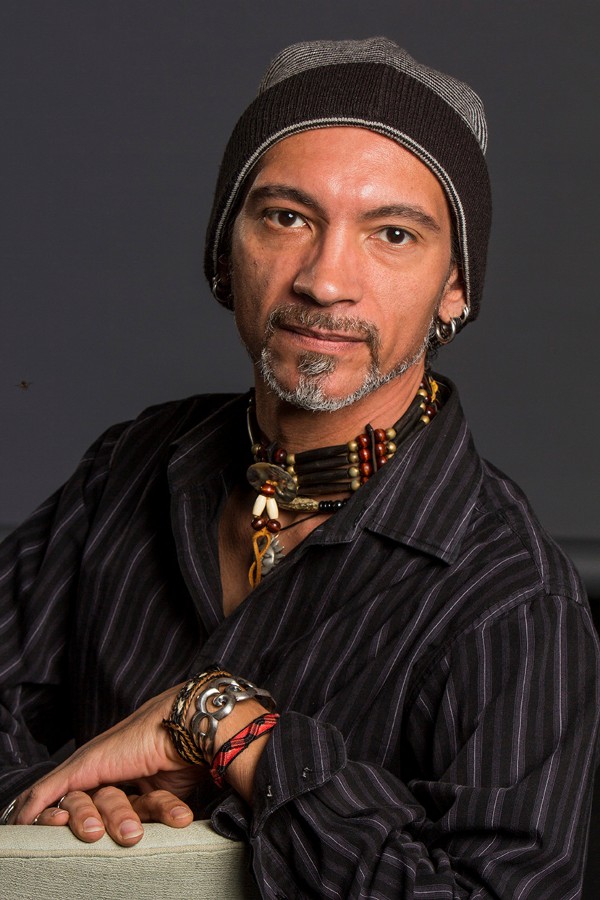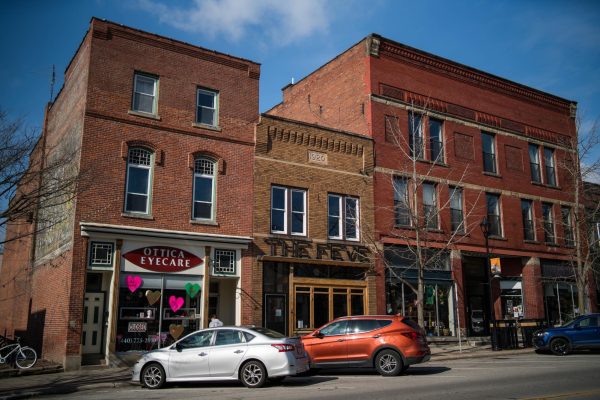OSCA Business Director Sundance Discusses His Role in OSCA, Oberlin Indigenous History
Sundance
Sundance, a member of the Muscogee (Creek) people, is the executive director of the Cleveland American Indian Movement and the business coordinator for the Oberlin Student Cooperative Association. On April 14, he was a panelist for a talk at the Allen Memorial Art Museum titled “Acknowledging the Land” in which he discussed the saliency of land acknowledgements for institutions that are located and operate on Indigenous land. In this conversation, Sundance talked about his activism against racist caricatures of Native people — such as the Cleveland baseball team’s former logo and mascot Chief Wahoo — as well as education about their history.
This interview has been edited for length and clarity.
When did you start working for OSCA?
I’ve been with OSCA for a long time. I believe I started working with OSCA in 2004 as a system administrator. I was in that role for quite some time. When the business coordinator position became available in 2016 I stepped into that role, and that’s where I’ve been ever since.
I help the students coordinate the business services of OSCA. I’m in an administrative position. My direct supervisors are the [OSCA] officers, the chair of the board, the membership secretary, and the president. My job is to work with them to help them do their jobs more efficiently and conveniently.
I went to your presentation on the Indigenous History of Ohio a few weeks ago — how does your work at AIM influence these educational workshops and what do you hope they accomplish?
I was doing this type of work before I started working for OSCA. I’ve been in the role of executive director of AIM since 2007. It’s my 15th year. I like working with the students at Oberlin. I do a lot of work with students at a number of colleges, because there’s no real place where a person — educated or otherwise — can go to get a concise and thorough picture of what this place was like before settlers. As I said in my talk, there’s a lot of information out there and some of it is contradictory. Some of it only appears so because the context is not presented, or not presented appropriately. So basically college students, just like anybody else in Ohio, trying to get an understanding of the history of Indigenous people here can easily be misinformed.
We did our first land acknowledgement at Oberlin—I am going to say that might have been 2004. I think it was the last time that the College had a functioning Native American Alliance on campus. I think at that point it became apparent that the Native people on campus really wanted to connect with Native people in the community. And so, we’d been trying to do that for Native people who come through all the way simply because we understand how difficult it is to be here and not have a community around you.
The Cleveland baseball team changed its name from the Indians to the Guardians last season. How is AIM moving forward from this victory?
It is a victory after approximately 50 years of demonstration. I am confident when I say it did not happen a moment too soon. How does that inform our work? Well, you know, there’s still a lot of work to be done in Ohio around sports mascots. Almost every county in Ohio has at least one school district that has a secondary school with an “Indian” head mascot or logo or some name or some sort of symbol that references Indigenous people. So there’s a lot of work to be done. I am hoping that in the next few years or so we will be able to have our concerns addressed and taken seriously by the institutions in power in Ohio, which are ostensibly there to serve and protect us.
The Ohio Department of Education, back in July 2020, passed a resolution calling for equal opportunity for people of color and to get rid of discrimination in the school system. Nowhere in that resolution did they address the mascot issues. Last year, in 2021 in June or July, I think there was a resolution introduced at the state house to encourage school systems to transition away from these Native-referenced sports teams. There was no teeth to that resolution, and as far as I know, it has not really gone anywhere. It took them several months just to get a cosponsor. So there’s a lot of work to be done. People in Ohio are under a number of illusions when it comes to Indigenous people. Conveniently enough for them, these illusions allow them to continue to practice the traditions that they have practiced for quite a while that have been discriminatory or harmful toward Indigenous people, and it allows them to do that with impunity.
When we talk about the lack of understanding of Indigenous history in Ohio and how it is not really being taught, that is convenient for settlers. You hear people talk and say, “Well, you know, the Natives here gave up these lands by treaty,” as if they wanted to do so. Yes, they gave them up by treaty, under duress and after a century of fighting the British, the French, and the Americans. I don’t believe people put it in that context. It cannot be said that they gave up Ohio under any circumstance other than a forcible one, but when you maintain that mythology, it is convenient. It allows people in Ohio to say, “Well, we didn’t do anything wrong.” Oftentimes in the history book, there are no Native people in Ohio. They were all run out of Ohio. How convenient is that? Settlers move into a place where all Native people have already been run out by, let’s say, other Native people. So that’s one mythology, and then there’s a second mythology that goes along with that: these sports teams are somehow honoring us because there happened to be at one point in time, back in the late 1800s, a Native person who played baseball in Cleveland. I’m sure there were other ethnicities that played baseball in Cleveland, but you don’t hear that as an excuse for saying the Cleveland Jews or the Cleveland Italians or any sort of other ethnicity, because of course when you put it in that perspective, that’s completely ridiculous. But somehow ridiculousness is the norm when it comes to talking about Indigenous people.
There’s this myth that Oberlin, from its founding, has been a sort of racial utopia. Works such as “Elusive Utopia” by former professors Carol Lasser and Gary John Kornblith have shown that really it wasn’t, despite the fact that the College began admitting Black students and women in its early years. In your talk you mentioned that during Oberlin’s founding there were peripheral accounts that somewhere on the southwest corner of Tappan Square — probably where King Building is now located — there was evidence of Indigenous presence?
Yeah. Not very much credence has been given to that story, although the person who related that to the Board of Trustees—I believe it was in 1845—has a building named after him. We’re talking about John Keep. So, the fact that he is honored in every other respect, but that respect remains hidden, calls into question the basis of the founding of Oberlin. When you put it into the context of the surrounding area, Lorain County had a lot of Indigenous people. There were people who came every spring through fall from Sandusky to hunt in this area. Many of them were driven out of this area by settlers who said that they were taking too many deer, hunting too much, thinking that this stuff just belongs to them and they can do whatever they want to. It is not a stretch of the imagination to think that Native people run out of one area, knowing that there is a road going to this area — what is now Oberlin — that no one is occupying. The predominance of historians who cover the founding of the College do not mention that. I mean, that’s typical. I found this fact in two places. One was in Historical Collections of Ohio, written by Henry Howe in 1847. The book quoted a Cleveland newspaper clipping which mentioned the Indian encampment in Oberlin. The only other place that I have found it in the histories I have read is in a footnote. So it seems to me that it is likely not apocryphal, as so many stories happen to be -— including some about Oberlin -— especially because John Keep was very specific about where everything was.
It raises some questions as to why the people involved early on would go so far as to cover it up. And perhaps that’s too strong of a word. Perhaps they weren’t covering up — perhaps they just didn’t care. Nothing to cover up if you don’t care. Easy enough not to mention if you don’t really put any credence in the fact that there is evidence here.
Another thing that I find interesting is that they use the phrase “unbroken wilderness” repeatedly, and in almost all their accounts. To me, that always raised suspicions. When historians choose a term that they all just repeat ad nauseam, that’s another indication that maybe there’s a little cover-up going on here.
I compare that to the Paiute prophet Wovoka, who invented the ghost dance back in the 1800s. He had grown up in some respects with a white family and had a lot of peers who were settlers when he was in his teen years, who knew him into his adulthood. What I found when I was looking at the notes taken by the author of the biography of Wovoka was that the people who “knew” him were trying to defame him. They all used basically the same words; these common phrases keep popping out. And to me, that marked a concerted effort to construct a narrative that might not otherwise exist, or perhaps to reinforce a narrative that does exist. When a person wants to reinforce a narrative that does exist, in my experience, they tend to do that in their own words. When they are trying to construct a narrative that does not exist, you pick up on the knee-jerk phrases. So, you know, “unbroken forest” is not a knee-jerk phrase, but it is a phrase that was used repeatedly by people describing Oberlin and its founding, which in my mind raises some questions at the very least.
Are there any upcoming demonstrations or events that people should know about?
We are discussing whether or not to have a demonstration down at Progressive Field on opening day. The Cleveland baseball team is no longer the Indians; they are officially the Guardians. The question is whether or not people want to continue that as sort of a bully pulpit, to inform people of issues that Indigenous people face, or whether we should focus on other avenues. On our website, there is a letter that people can sign to send to their state representative or state senator asking them to support legislation to remove Indigenous sports mascots from the school systems. We’re beginning to prepare for Indigenous People’s day, but that’s not for another few months. I’m talking at the Massillon Museum April 28, which is in tandem with poet laureate Joy Harjo’s visit.







